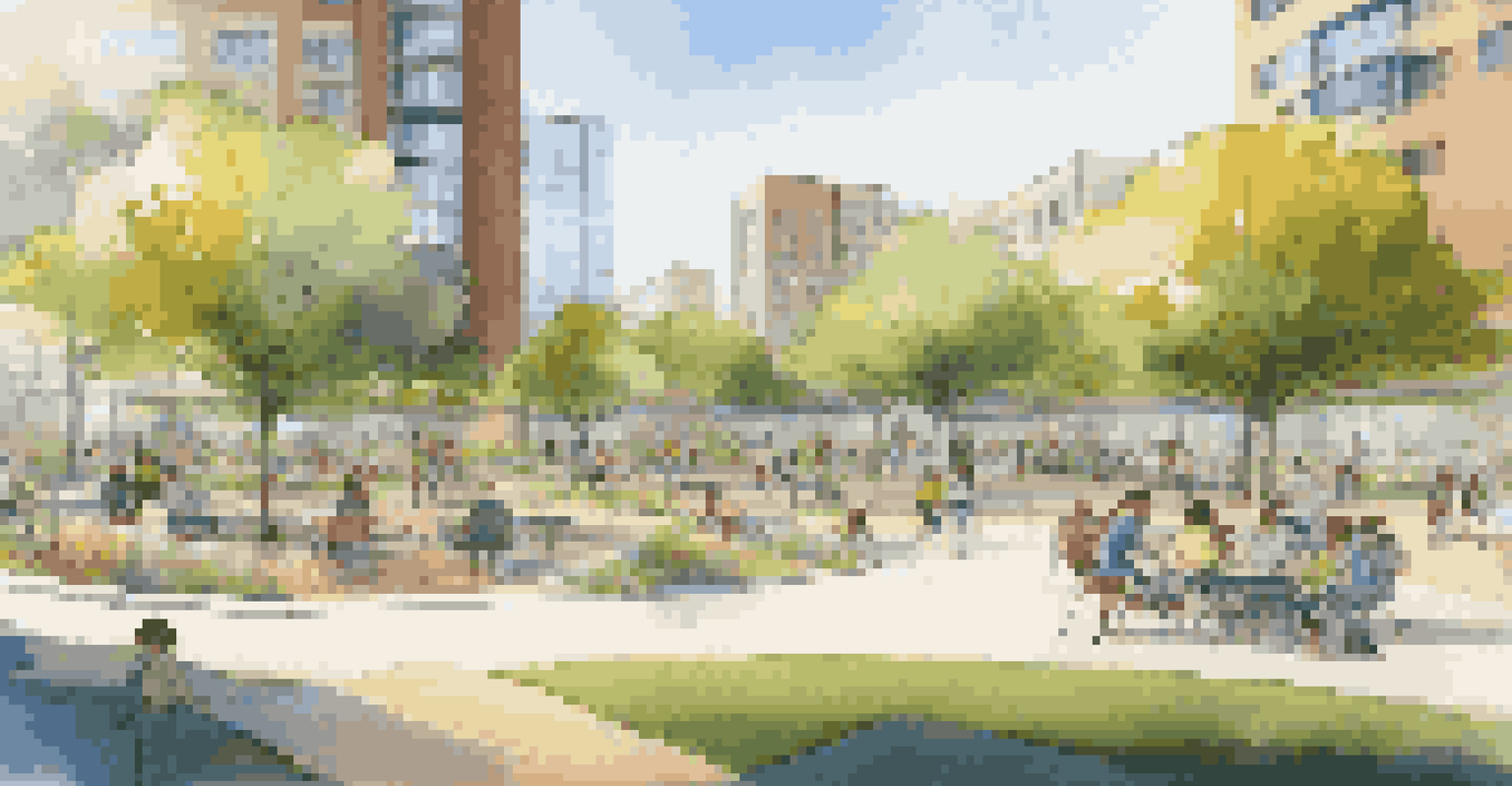Smart City Innovations: Enhancing Urban Livability

Understanding Smart Cities and Their Benefits
Smart cities are urban areas that leverage technology to enhance the quality of life for their residents. By integrating IoT (Internet of Things) devices, cities can optimize resources and improve efficiency in various sectors like transportation, energy, and public services. This innovative approach not only makes daily life more convenient but also contributes to sustainability and environmental health.
The city is not a concrete jungle, it is a human zoo.
Imagine a city where traffic lights adjust in real-time based on vehicle flow, reducing congestion and emissions. Or consider public transport systems that provide real-time updates about arrivals and delays, making commuting smoother. These benefits underscore the transformative potential of smart city initiatives.
Moreover, smart cities often prioritize citizen engagement, allowing residents to participate in decision-making processes. By fostering a sense of community involvement, cities can better address the specific needs and preferences of their inhabitants, ultimately enhancing urban livability.
Smart Mobility Solutions for Urban Transportation
Transportation is often one of the most significant pain points in urban living. Smart mobility solutions aim to alleviate this issue by utilizing technology to create more efficient transportation networks. Features like ride-sharing apps, electric scooters, and autonomous vehicles are just a few examples of how technology is reshaping urban mobility.

For instance, cities like San Francisco have implemented smart parking systems that guide drivers to available spots, reducing the time spent searching for parking. This not only saves time but also lowers fuel consumption and emissions, contributing to a cleaner environment.
Smart Cities Enhance Urban Living
By leveraging technology, smart cities improve efficiency in transportation, energy, and public services, ultimately enhancing the quality of life for residents.
Additionally, smart public transport systems are being enhanced with apps that provide real-time tracking and updates. This empowers commuters with information, improving their overall travel experience and encouraging the use of public transportation over private vehicles.
Sustainable Energy Solutions in Smart Cities
A cornerstone of smart city initiatives is the integration of sustainable energy solutions. Cities are increasingly adopting renewable energy sources like solar and wind power, reducing reliance on fossil fuels. This shift not only addresses climate change but also promotes energy independence and resilience.
Sustainability is no longer about doing less harm. It's about doing more good.
Consider the example of Barcelona, which has invested in solar panels and smart grids to optimize energy use across the city. These technologies allow for efficient distribution of energy, reducing waste and lowering costs for residents. Such initiatives demonstrate how smart energy solutions can enhance urban livability by creating a cleaner and more sustainable environment.
Furthermore, energy management systems that monitor consumption patterns can help cities identify areas for improvement. By leveraging big data, cities can develop strategies to reduce energy usage during peak times, ultimately benefiting both the environment and the economy.
Enhancing Public Safety with Smart Technology
Public safety is a top priority for any city, and smart technology plays a crucial role in enhancing security measures. Surveillance systems equipped with AI can analyze footage in real time, helping law enforcement respond quickly to incidents. This proactive approach can significantly improve community safety and deter criminal activity.
For example, cities like Chicago have implemented smart streetlights that not only illuminate public spaces but also serve as surveillance cameras. This dual function allows for better monitoring of urban areas and enables quick responses to emergencies, creating a safer environment for residents.
Sustainable Energy Drives Change
Integrating renewable energy sources in urban areas promotes sustainability, reduces reliance on fossil fuels, and improves energy management.
Moreover, community engagement platforms can facilitate communication between citizens and law enforcement. Through apps or social media, residents can report issues or concerns, fostering a collaborative approach to public safety and ensuring that communities feel heard and protected.
Waste Management Innovations for Cleaner Cities
Waste management is an often-overlooked aspect of urban livability, yet it's essential for maintaining clean and healthy cities. Smart waste management solutions use sensors in bins to monitor fill levels, optimizing collection routes and schedules. This technology not only reduces operational costs but also minimizes the environmental impact of waste collection.
Take the example of Stockholm, where smart bins equipped with sensors alert waste management services when they need to be emptied. This system prevents overflowing bins, which can attract pests and create unsightly public spaces. By streamlining waste collection, cities can maintain cleanliness and enhance the overall livability of urban areas.
Additionally, some cities are implementing recycling programs that use technology to educate residents about proper waste disposal. By promoting responsible waste management practices, cities can encourage a culture of sustainability and environmental stewardship among their citizens.
Transforming Urban Spaces with Smart Infrastructure
Smart infrastructure is reshaping the way we think about urban spaces. By incorporating technology into buildings and public areas, cities can create environments that are not only functional but also enjoyable for residents. Features such as smart lighting, energy-efficient materials, and green roofs contribute to a more sustainable urban landscape.
For instance, cities like Singapore have embraced vertical gardens and smart facades in their architectural designs. These innovations improve air quality and reduce heat absorption, making urban spaces more livable. The integration of nature and technology offers a refreshing contrast to the concrete jungle typically associated with cities.
Citizen Engagement is Crucial
Digital platforms for citizen engagement foster collaboration and ensure that urban development aligns with community needs and preferences.
Moreover, smart infrastructure can enhance accessibility for all residents. Features like interactive maps and digital information kiosks can help individuals navigate urban spaces more easily, ensuring that everyone can enjoy the benefits of a smart city.
Citizen Engagement Through Smart City Platforms
Citizen engagement is vital for the success of smart city initiatives. By using digital platforms, cities can encourage residents to participate in decision-making processes and provide feedback on urban projects. This collaborative approach fosters a sense of ownership and accountability among citizens, leading to more effective solutions.
For example, cities like Amsterdam have implemented digital platforms that allow residents to propose ideas for community projects and vote on them. This participatory model ensures that urban development aligns with the needs and desires of the community, enhancing overall livability.

Furthermore, these platforms can serve as a channel for communication between city officials and residents. By keeping citizens informed about upcoming projects and initiatives, cities can build trust and transparency, ultimately creating a more engaged and satisfied community.